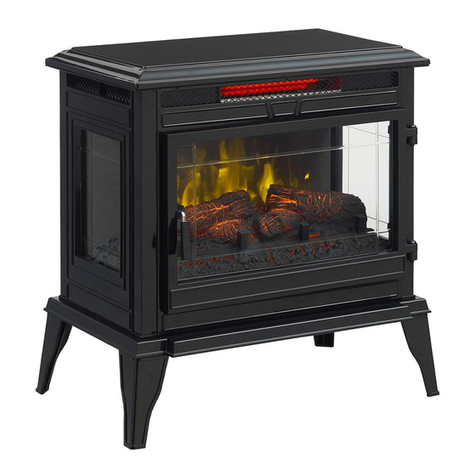
9Operating Instructions and Owner’s Manual
Grand Teton Wood Pellet Fire Stove
CONNECTOR REQUIREMENTS AND ASSEMBLY
CAUTION: A CHIMNEY CONNECTOR SHALL
NOT PASS THROUGH AN ATTIC OR ROOF
SPACE, CLOSET OR SIMILAR CONCEALED
SPACE, OR A FLOOR, OR CEILING. WHERE
PASSAGE THROUGH A WALL, OR PARTITION
OF COMBUSTIBLE CONSTRUCTION
IS DESIRED, THE INSTALLATION
SHALL CONFORM TO CAN/CSA-B365,
INSTALLATION CODE FOR SOLID-FUEL-
BURNING APPLIANCES AND EQUIPMENT
Any connector pipes or elbows should be installed with
the crimped end on the stove end of the path (not the
chimney cap end) and should be secured with three
evenly spaced sheet metal screws.
Connectors, elbows, and chimneys should be type
‘L’ or ‘PL’ and have a 80mm, or 3 inch diameter as
the flue system is based on negative pressure in the
combustion chamber and a slight overpressure on the
flue gas outlet. It is therefore important that the flue
gas connection is fitted correctly and is airtight.
It is recommended that connectors, elbows, and
chimneys be at least 24 gauge, double walled, type B
ventilation.
Note that bends in the exhaust path restricts air flow,
reducing performance and provides a collection point
for ash deposits requiring more frequent cleaning.
CAUTION: THE JOINTS OF ANY AND ALL
CONNECTIONS FOR ANY VENTILATION
SYSTEMS (COMBUSTION EXHAUST
AND OPTIONAL INLET AIR DUCT) MUST
BE SEALED WITH HIGH TEMPERATURE
SILICONE.
GENERAL VENTING REQUIREMENTS
CAUTION: DO NOT CONNECT TO ANY AIR
DISTRIBUTION DUCT OR SYSTEM.
CAUTION: DO NOT CONNECT THIS UNIT
TO A CHIMNEY FLUE SERVING ANOTHER
APPLIANCE.
CAUTION: DO NOT INSTALL A FLUE DAMPER
IN THE EXHAUST VENTING SYSTEM OF THIS
WOOD PELLET FIRED STOVE.
This wood pellet fire stove must be connected to either
of the following:
• Class A listed chimney complying with the
requirements for Type HT chimneys in the Standard
for Chimneys, Factory-Built, Residential Type and
Building Heating Appliance, UL 103.
• A International Conference of Building Officials
(ICBO) standards for solid fuel Stoves code-
approved masonry chimney.
VENT TERMINATION
• Install exhaust vent at clearances specified by the
vent manufacturer.
• Install exhaust vent terminations at clearances
specified by the vent manufacturer.
• If using the air intake kit, ensure that there is at
least 12 inches clearance between the exhaust vent
termination and the intake air inlet.
• It is recommended to keep at least 12” (30.5 cm)
of clearance between any vent termination and
windows, doors, or outside corners.
• Use silicone to create an effective vapor barrier at
the location where the chimney or other component
penetrates to the exterior of the structure.
• For additional requirements check local codes.
Any vertically terminated chimney systems must meet
the following minimum requirements:
• Must be at least 15 feet (4.6 m) tall, measured from
the top of the stove to the tip of the chimney cap.
• Must be at least 3 feet above the roof, measured
from the highest point of contact with the roof and
the tip of the chimney cap.
• Must be at least 2 feet (61 cm) above the highest
point of the slope of the roof within 10 feet (305
cm) horizontally.
Any horizontally terminated chimney systems must
meet the following minimum requirements:
• Must have at least 12” (30.5 cm) clearance above
grade, veranda porch, deck or balcony (Including
vegetation and mulch).
PASSING THROUGH A WALL
Where passage through a wall or partition of
combustible construction is desired, the installation
shall conform to chimney manufacturer’s instructions.
NOTE: In Canada, installation must conform to
CAN/CSA-B365 when passing through combustible
construction, illustrated in figure 6 .
Hole with a minimum
clearance of 18”(450
mm) between
connector and wall
1” (25mm) clearance
Stove connector pipe
Non-combustible cover, one
side only. If two covers are
used, each must be mounted
on non-combustible spacers
at least 7/8” (21mm) away
from the wall.
Figure 6
ONLY APPROVED CANADIAN WALL PASS
THROUGH




























